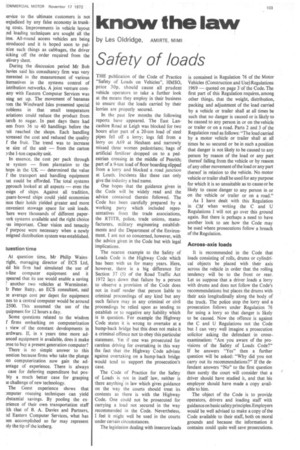know the law
Page 109

If you've noticed an error in this article please click here to report it so we can fix it.
by Les Oldridge, AM1RTE, MIMI
Safety of loads
THE publication of the Code of Practice "Safety of Loads on Vehicles", HMSO, price 30p, should cause all prudent vehicle operators to take a further look at the means they employ in their business to ensure that the loads carried by their lorries are properly secured.
In the past few months the following reports have appeared. The East Lancashire Road at Leigh was blocked for two hours after part of a 20-ton load of steel pipes fell off a lorry; logs fell from a lorry on A69 at Hexham and narrowly missed three women pedestrians; bags of artificial fertilizer dropped on to a pedestrian crossing in the middle of Penrith; part of a 9-ton load of floor boarding slipped from a lorry and blocked a road junction at Louth. Incidents like these can only give the industry a bad name.
One hopes that the guidance given in the Code will be widely read and the advice contained therein followed. The Code has been carefully prepared by a working party which included representatives from the trade associations, the RTITB, police, trade unions, manufacturers, military engineering establishments and the Department of the Environment. I am not so concerned, however, with the advice given in the Code but with legal implications.
The nearest example to the Safety of Loads Code is the Highway Code which has been with us for many years. Here, however, there is a big difference for Section 37 (5) of the Road Traffic Act 1972 lays down that failure by a person to observe a provision of the Code does not in itself render that person liable to criminal proceedings of any kind but any such failure may in any criminal or civil proceedings be relied upon as tending to establish or to negative any liability which is in question. For example the Highway Code states it is wrong to overtake at a hump-back bridge but this does not make it a criminal offence not to obey this particular statement. Yet if one was prosecuted for careless driving for overtaking in this way the fact that the Highway Code advises against overtaking on a hump-back bridge would tend to support the prosecution's case.
The Code of Practice for the Safety of Loads is not in itself law, neither is there anything in law which gives guidance on the way the courts should treat its contents as there is with the Highway Code. One could not be prosecuted for carrying a load not secured in the way recommended in the Code. Nevertheless, I feel it might well be used in the courts under certain circumstances.
The legislation dealing with insecure loads is contained in Regulation 76 of the Motor Vehicles (Construction and Use)Regulations 1969 — quoted on page 3 of the Code. The first part of this Regulation requires, among other things, that the weight, distribution, packing and adjustnient of the load carried by a vehicle or trailer shall at all times be such that no danger is caused or is likely to be caused to any person in or on the vehicle or trailer or on a road. Parts 2 and 3 of the Regulation read as follows: "The load carried by a motor vehicle or trailer shall at all times be so secured or be in such a position that danger is not likely to be caused to any person by reason of the load or any part thereof falling from the vehicle or by reason of any other movement of the load or any part thereof in relation to the vehicle. No motor vehicle or trailer shall be used for any purpose for which it is so unsuitable as to cause or be likely to cause danger to any person in or on the vehicle or trailer or on a road?'
As I have dealt with this Regulation in CM when writing the C and U Regulations I will not go over this ground again. But there is perhaps a need to have another look to see how the Code may be used where prosecutions follow a breach of the Regulation.
Across-axis loads It is recommended in the Code that loads consisting of rolls, drums or cylindrical objects be placed with their axis across the vehicle in order that the rolling tendency will be to the front or rear. Let us suppose that a driver loads a lorry with drums and does not follow the Code's recommendations but places the drums with their axis longitudinally along the body of the truck. The police stop the lorry and a prosecution follows under Regulation 76 for using a lorry so that danger is likely to be caused. Now the offence is against the C and U Regulations not the Code but I can very well imagine a prosecution solicitor asking the defendant in crossexamination: "Are you aware of the provisions of the Safety of Loads Code?" If he answers "Yes" then a further question will be asked: "Why .did you not carry out its recommendations?" If the defendant answers "No" to the first question then surely the court will consider that a driver should have studied it, and that his employer should have made a copy available to him.
The object of the Code is to provide operators, drivers and loading staff with guidance on basic safety principles.Employers would be well advised to make a copy of the Code available to their staff, both on moral grounds and because the information it contains could quite well save prosecutions.
































































































































































